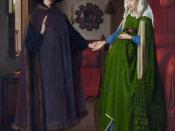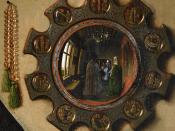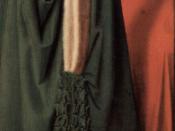In Erwin Panofsky's article he proposes the idea that the Arnolfini Portrait is a wedding portrait that acts as a "pictorial marriage certificate." He uses comparison to other similar works of his time and matrimonial literature and documents to confirm his theory. The Marriage of David and Michal, comes from a French Psalter and is a representation of a marriage ceremony. In both works of art, The Marriage of David and Michal and the Arnolfini Portrait, there is the absence of a priest and also the raising of the forearm and the joining of hands. There exists, in the painting, an outstanding amount of iconography that helps prove the theory of the painting's creation for a wedding. Some of this iconography includes, but is not limited to: the single, burning candle symbolizing the "all seeing wisdom of god"; the dog at the subject's feet, a symbol of purity; the joining of hands, symbolizing matrimony; the mirror, symbolizing purity; the removal of shoes, symbolizing a holy place; and the carving of St.
Margaret on the armchair, who was prayed to before childbirth. Panofsky states that these are not symbols; rather they are attributes because "they "belong" to a Nuptial Chamber and to a marriage ceremony." The writing above the mirror, which when roughly translated means "Jan van Eyck was here," would make the artist a witness to the marriage, carrying the same legal binding as, in modern times, a signed affidavit by a witness. Panofsky also uses other paintings of Van Eyck's, such as the Virgin of Lucca and the image of St. Barbara, to illustrate his history of "disguised" symbolism.
In Linda Seidel's article she proposes the idea that the Arnolfini Portrait is a form of a "receipt" for the items given as a dowry by Signor Cemani,



Is this an essay?
I believe that these are responses to articles. However, without access to the articles it concerns it is hard to know whether or not these are good explanations. Furthermore, it seems that many paragraphs repeat each other (use of similar information).
1 out of 2 people found this comment useful.